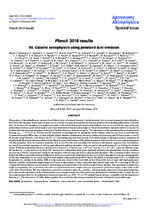| dc.contributor.author | Aghanim, Nabila | |
| dc.contributor.author | Akrami, Yashar | |
| dc.contributor.author | Alves, Marta I.R. | |
| dc.date.accessioned | 2020-11-06T12:18:24Z | |
| dc.date.available | 2020-11-06T12:18:24Z | |
| dc.date.issued | 2020 | |
| dc.identifier.citation | Aghanim, N. et al . (2020). Planck 2018 results: XII. Galactic astrophysics using polarized dust emission.Astronomy and Astrophysics, 641,A12 . Doi: https://doi.org/10.1051/0004-6361/201833885 | en_US |
| dc.identifier.issn | 1432-0746 | |
| dc.identifier.uri | http://hdl.handle.net/10566/5383 | |
| dc.description.abstract | Observations of the submillimetre emission from Galactic dust, in both total intensity I and polarization, have received tremendous interest thanks to the Planck full-sky maps. In this paper we make use of such full-sky maps of dust polarized emission produced from the third public release of Planck data. As the basis for expanding on astrophysical studies of the polarized thermal emission from Galactic dust, we present full-sky maps of the dust polarization fraction p, polarization angle ψ, and dispersion function of polarization angles 𝒮. The joint distribution (one-point statistics) of p and NH confirms that the mean and maximum polarization fractions decrease with increasing NH. | en_US |
| dc.language.iso | en | en_US |
| dc.publisher | EDP Sciences | en_US |
| dc.subject | Polarization | en_US |
| dc.subject | Magnetic fields | en_US |
| dc.subject | Turbulence | en_US |
| dc.subject | Local insterstellar matter | en_US |
| dc.subject | Extinction | en_US |
| dc.title | Planck 2018 results: XII. Galactic astrophysics using polarized dust emission | en_US |
| dc.type | Article | en_US |

